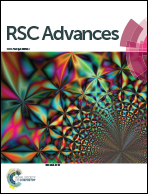Asymmetric Mannich reaction: highly enantioselective synthesis of 3-amino-oxindoles via chiral squaramide based H-bond donor catalysis†
Abstract
We describe here a simple and facile asymmetric Mannich reaction catalyzed by chiral Cinchona alkaloid based squaramide containing H-bond donor catalysts, wherein, the reaction of 1,3-diketones with isatin (N-Boc) ketimines led to the formation of 3-aminooxindole derivatives. These derivatives were obtained in high yields with excellent enantioselectivities under mild conditions using 3 mol% of the catalyst. This protocol provides valuable and easy access to chiral 3-substituted 3-aminooxindole derivatives.

- This article is part of the themed collection: Editors’ collection: Catalytic Organic Transformations

 Please wait while we load your content...
Please wait while we load your content...